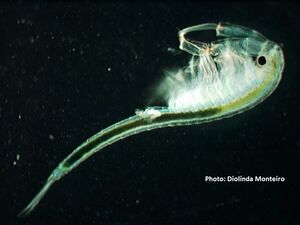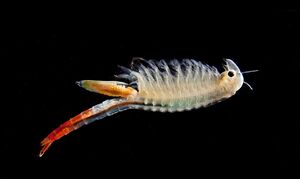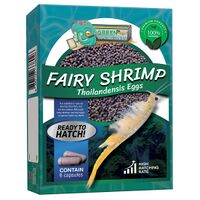Anostraca

Anostraca is one of the four orders of crustaceans that compose the class Branchiopoda, the other three being Notostraca, Laevicaudata, and Diplostraca. The members of the Anostraca order are more commonly referred to as "fairy shrimp" or "brine shrimp". They swim upside-down and are typically found in Vernal Pools and hypersaline lakes (landlocked lakes that contain high levels of sodium chloride and other salts). Being the most diverse order of Branchiopoda, they have over 300 species across 8 families, and can be found in places such as deserts, colder regions, and mountains as well. Anostraca are a primary food source for many animals, including fish and birds. Additionally, they are cultivated by humans to be used as fish food.
Taxonomy
| Kingdom | Phylum | Subphylum | Class | Subclass | Order | |
|---|---|---|---|---|---|---|
| Classification | Animalia | Arthropoda | Crustacea | Branchiopoda | Sarsostraca | Anostraca |
Description
A fairy shrimp's body is typically elongated and segmented into three distinct parts: head, abdomen, and thorax. The animal typically measures anywhere from .25 - 1 inch long (6-25 millimeters); however, some species may reach almost 7 inches (170 mm)[1]. Fairy shrimp possess a thin but flexible exoskeleton that unlike other arthropods does not have a carapace (an upper section of exoskeleton found in many groups of animals) [1].

Head
The head of fairy shrimp possesses two compound eyes and two separate pairs of antennae. The shape of the second pair of antennae differ between males and females of the species; the males second pair of antennae are enlarged and specialized (instead of long and cylindrical) in order to be able to better hold females during mating [7].
Thorax and Abdomen
Most members of this order have a thorax with 13 segments with the exception of Polyartemiella and Polyartemia which possess 19 and 21 segments respectively. Each segment houses a pair of legs. All segments but the last two are similar in that they have a pair of flattened leaf-like appendages [1]. The last two segments of the body contain specialized appendages for sexual reproduction. Most fairy shrimp reproduce sexually, however a few reproduce by parthenogenesis. The abdomen has 6 segments which do not contain appendages, and a telson, which bears two flattened cercopods.
Sexual Dimorphism
In addition to the males' extra antennae, there are more differences between male and female anostraca. Certain species of males possess extra antennae appendages. Behind the legs exists the genitalia. Males have a pair of of ventral gonopods (arthropod reproductive organ, in males, used for transferring sperm) [9]. Females have a brood pouch within which are oviductal pouches, a median ovisac, and shell glands [11].
Anatomy
The head contains two digestive glands as well as the stomach. This feeds into an intestine which is followed by the rectum and ends with the anus which is on the telson. The haemocoel (arthropod substitute for circulatory system; the cavity in which their organs reside and are flooded with nutrients) is fueled by a long tube shaped heart, which takes up much of the body length [10]. The nervous system of the anostraca functions by way of two nerve cords with two ganglia and commissures to match [10].
Ecology
Anostracans swim by moving their phyllopodia (leg like appendages on the thorax segments). When swimming, fairy shrimp will have their ventral side facing upward, which is why it is said that they are "swimming upside-down" [3]. While swimming, they filter food indiscriminately from the water and scrape algae and other organic materials from solid surfaces, pressing said ventral side against the food source [5].
Fairy shrimp are characterized by their ability to enter diapause, which is a state of dormancy where all growth and metabolism pause, as an egg (or cyst) [4]. This is an especially important biological trait because it assists in both species' dispersal and overcoming difficult environmental conditions. The Fairy shrimp cyst can withstand conditions anywhere from UV radiation, to droughts, frosts, hyper salinity, and even the vacuum of space. Diapause is also how fairy shrimp to colonize new habitats. This movement is facilitated by a variety of conditions such as predators, wind, and currents within water as the adults are unable to leave the freshwater system [4].
Distribution and Habitat
Fairy shrimp inhabit inland waters including vernal ponds, salt lakes, and lakes at high altitudes or latitudes. Due to their relatively large size and slow means of locomotion, Anostracans are easy prey for predatory fish and waterfowl [2]. This susceptibility to predation causes their range to be restricted to areas with a lower quantity of predators. Anostracans can be found on every continent including Antarctica [9]. Anostraca have been found in deserts, in the Antarctic, or in the Chilean Andes at elevations of 19,000 feet [10].
Feeding

Most anostraca are omnivorous. Different species eat different substances which varies from algae, plankton and organic particles from the water. Some feed on algae by scraping hard algae covered surfaces with their legs which then makes the algae more accessible to feed on. They also use their legs to indiscriminately filter feed organic particles from the water as they swim [10]. Some species are predatory towards copepods, rotifers, cladocerans, and other anostraca [9].
Environmental Impact

Members of this order, most notably brine shrimp, are used as fish food and food for other organisms in aquaculture. In natural environments they are also eaten by birds, water boatmen, fish, and other crustaceans. Their drought-resistant eggs are collected from lakeshores then transported while dry. Following transportation, they hatch when submerged in water. This is a large industry centered in the Great Salt Lake in Utah and San Francisco Bay [6].
Diversity
Of the four orders of Branchiopoda, Anostraca has the widest diversity range. There are approximately 313 species in it, arranged into 26 genera and eight families:
- Artemiidae – 1 genus, 8 species
- Branchinectidae – 1 genus, 45 species
- Branchipodidae – 5 genera, 35 species
- Chirocephalidae – 9 genera, 81 species
- Parartemiidae – 1 genus, 18 species
- Streptocephalidae – 1 genus, 56 species
- Tanymastigidae – 2 genera, 8 species
- Thamnocephalidae – 6 genera, 62 species
To differentiate anostracan species, the most common method is to examine the structure of the second male antennae [9].
References
[1] Peter H. H. Weekers; Gopal Murugan; Jacques R. Vanfleteren; Denton Belk; Henri J. Dumont (2002). "Phylogenetic analysis of anostracans (Branchiopoda: Anostraca) inferred from nuclear 18S ribosomal DNA (18S rDNA) sequences" Pg. 535–544. doi:10.1016/S1055-7903(02)00289-0. PMID 12450757.
[2] Vernal Pool Fairy Shrimp. National Wildlife Federation. (n.d.). Retrieved May 10, 2022, from https://www.nwf.org/Educational-Resources/Wildlife-Guide/Invertebrates/Vernal-Pool-Fairy-Shrimp
[3] “Fairy Shrimp.” 2022. Fairy Shrimp | Merced Vernal Pools & Grassland Reserve. Accessed May 10. https://vernalpools.ucmerced.edu/ecosystem/reserve-fairy-shrimp.
[4] Fryer, Geoffrey (1996-03-01). "Diapause, a potent force in the evolution of freshwater crustaceans". Hydrobiologia. 320 (1–3): 1–14. doi:10.1007/bf00016800
[5] Denton Belk (2007). "Branchiopoda". In Sol Felty Light; James T. Carlton (eds.). The Light and Smith Manual: Intertidal Invertebrates from Central California to Oregon (4th ed.). University of California Press. pp. 414–417. ISBN 978-0-520-23939-5.
[6] J. M. Melack (2009). "Saline and soda lakes". In Sven Erik Jørgensen (ed.). Ecosystem Ecology. Academic Press. pp. 380–384. ISBN 978-0-444-53466-8.
[7] William David Williams (1980). "Arachnids and Crustaceans". Australian Freshwater Life: the Invertebrates of Australian Inland Waters (2nd ed.). Palgrave Macmillan Australia. pp. 118–184. ISBN 978-0-333-29894-7
[8] The Editors of Encyclopaedia Britannica. “Brine Shrimp | Crustacean.” Encyclopædia Britannica, 2019, www.britannica.com/animal/brine-shrimp.
[9] Luc Brendonck; D. Christopher Rogers; Jorgen Olesen; Stephen Weeks; Walter R. Hoch (2008). "Global diversity of large branchiopods (Crustacea: Branchiopoda) in freshwater". In Estelle V. Balian; Christian Lévêque; Hendrik Segers; Koen Martens (eds.). Freshwater Animal Diversity Assessment. Developments in Hydrobiology 198. pp. 167–176. doi:10.1007/s10750-007-9119-9. ISBN 978-1-4020-8258-0. S2CID 46608816. Reprinted from Hydrobiologia, Volume 595
[10] Anostraca. (2025). In Wikipedia., Accessed March 3 2025, https://en.wikipedia.org/w/index.php?title=Anostraca&oldid=1278274678
[11] Thorp, J. H., & Rogers, M. B. A. (2014). Thorp and Covich’s Freshwater Invertebrates: Ecology and General Biology. Elsevier Science & Technology., Accessed March 3 2025, http://ebookcentral.proquest.com/lib/buffalo/detail.action?docID=1781029